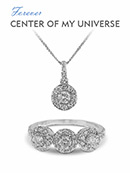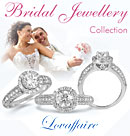The 4 C's of Diamonds -
Color, Cut, Clarity and Carat Weight
Diamond is a fascinating material which lured humans from times immemorial -
from the biggest of the Kings of the yester years to every woman of today's times. In
simplest terms, it is pure elemental carbon - the element that makes up the all too
familiar coal. But then what makes diamond so attractive? To understand diamonds, one has
to pretty much understand the 4 C's of diamonds. The 4 C's are - cut, color, clarity, and
carat weight. Jewelers use these 4 parameters to grade the diamonds and this brief guide
simplifies these four C's of diamonds, so you can select your diamond more confidently.
Finished diamonds are available in a variety of shapes. The most
popular are round, marquise, pear, emerald, oval, heart, square, princess, baguette and
trillion. Round is the most common and all other shapes are considered fancy shapes. Fancy
shapes are generally more expensive because they are more difficult to cut.
Although as a buyer one may be most interested in the shape and size (i.e. carat
weight), which are the most obvious properties, it's important to consider the other C's
too, the color and cut. Even if the shape and size are same, diamonds of substantially
different cut and color will vary widely in price.
Cut determines the brilliance of the diamond and refers to the precise proportions and
dimensions of the stone. Cut should not be confused with its shape. Cut is considered by
far the most important property of the diamond. A stone that has been cut properly allows
light to enter and refract through the stone, which creates brilliance. Symmetry of the
cut is very important in the behavior of light passing through the diamond. An experienced
diamond cutter knows that the a diamond that is too shallow or too deep will not refract
the light fully and will look dull.
The more color a diamond has, the more light it will absorb thus less
light will pass through the stone thus making it less brilliant. Thus, a colorless diamond
will create the maximum brilliance. Colorless diamonds,
however, are extremely rare and therefore very expensive. Colorless and near-colorless diamonds
are most highly valued and are priced accordingly. Other diamonds may have a slight tint
of color, and some can even have a noticeable tint which can diminish the
brilliance. Diamonds are color graded on a 23 point scale, from D to Z, D being completely
colorless and Z having noticeable color.
Like any other naturally occurring material, diamond also has
some impurities. These are called inclusions. Inclusions are small amounts of foreign
minerals trapped inside the stone during its formation millions of years ago. The
characteristics of the inclusions determine the clarity of the diamond. Diamonds that have
no inclusions will reflect more light and are very rare. Nearly all diamonds contain these
inclusions which make each stone unique. Most are unseen to the unaided eye. Jewelers need
magnifiers to identify them.
Diamonds completely free from internal flaws, or inclusions, are very
rare and highly valued. Clarity is graded based on the number, location, size, and type of
the inclusions found in a diamond. Below is the chart defining the different clarity
levels of diamonds.
| Clarity |
Description |
| FL, IF |
Flawless - No internal or external flaws. Internally Flawless - No
internal flaws. Very rare and beautiful diamonds. Very expensive. |
| VVS1, VVS2 |
Very, Very Slightly Included. Very difficult to see inclusions
under 10x magnification. An excellent quality diamond. |
| VS1, VS2 |
Very Slightly Included. Inclusions are not typically visible to the
unaided eye. Less expensive than the VVS1 or VVS2 grades. |
| SI1, SI2 |
Slightly Included: Inclusions are visible under 10x magnification, and may
be visible to the unaided eye. A good diamond value. |
| I1, I2, I3 |
Visible inclusions. Least expensive. |
The setting for your stone is like the setting of the picture in the frame; it holds and protects the stone, and
enhances its beauty. There are several different setting styles used in jewelry making. As you
search for the perfect piece of jewelry, it helps to know that different settings will
complement your stone and your lifestyle. Prong, channel and invisible are the most common settings.
Carat is the term used to express the weight of a diamond, with one
carat equaling 200 milligrams. Total carat weight (T. W.) is the total weight of all the
stones in a piece of jewelry. For example, a ring with one 1/2 carat stone and four 1/8
carat stones would have a T. W. of 1 carat. Since larger diamonds are more rare than
smaller diamonds, diamond value tends to rise exponentially with carat weight. Also, a diamond
of double the carat weight will not appear to be twice the diameter of the smaller
diamond.
|






